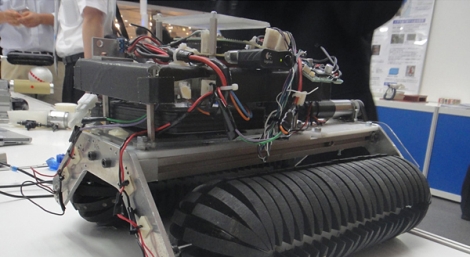
It’s always interesting to see new and innovative means of robot locomotion. At the recent “Innovation Japan 2011” conference researchers from Osaka University unveiled the Omni-Crawler, which is aimed at changing the way both robots and people move.
The Omni-Crawler’s movement is provided by Omni-Balls, an Osaka University creation that moves in all directions, not unlike a swivel caster. The Omni-Ball is simpler and sturdier in design however, making it far more robust than its office chair counterpart.
Several of these Omni-Balls are attached to the crawler, and wrapped in a rubber tank tread like gripper material. The resultant motion is predictably omnidirectional, though we’re guessing you figured that out already thanks to Osaka University’s naming conventions.
While we’re not sure this technology will be making it into production cars any time soon, we would certainly be OK with having an RC Omni-Crawler to play around with in the office.
Stick around after the break to see a short video of the Omni-Crawler in action.
[via BuildLounge]
[youtube=http://www.youtube.com/watch?feature=player_embedded&v=BTp2UAaihaI&w=470]















So much awesome in one video
The odometry in this thing will be a pain (as in all treaded robots). As soon as you turn, you’re lost
take an average of both treads?
That’s not so easy to do. You can know the velocity of each tread easily, but as to where the actual centre of rotation of the vehicle will be, that’ll depend a lot on the slipping motion and the ground contact.
It’s a pain for odometry, yep, and would have made robots 15 years ago useless, but we have sensors now that make odometry massively less necessary than it was.
Stick an IMU + digital compass on the bot, and possibly augment it with a couple of ground facing cameras doing optical-flow (e.g. two hacked mice) and you should be able to get a ‘go-anywhere’ bot that’ll know its position quite accurately.
Dead reckoning doesn’t work well to begin with.
Even with two regular wheels. If you try to turn 45 degrees and then drive 10 feet, but you actually slip a tiny bit and turn 35 degrees, you’re off by quite a bit.
So you’re best using absolute methods like SLAM or GPS (depending on the size of your environment).
who needs an odometer when there’s GPS to track your path…?
As long as you can see the sky (and enough GPS satelites) and as long as you have military grade GPS receiver.
Or a galileo connection, which by the time this hits market will probably be better then milltary GPS.
With todays microprocessors and optical camera’s, you could even track based on known visual enviromental points too. (as some firms are looking into to for getting more precise mobile phone positioning for AR use).
Looks great, but I’m confused by the singularity when the omniball is resting with the transverse axle pointed vertically. It seems like motion in only one direction would be possible (you see this briefly when the guy is rolling the ball with dots around). I’m not sure how to avoid the singularity without adding some sort of third gimbling axis – perhaps driving a single spherical ball with three drive wheels (a la Ballbot). Still, pretty cool.
Paul — I think this page at Osaka University will make things a bit clearer (if I understand your question properly). There’s a tiny free-spinning wheel located at the problem spot:
http://www-hh.mech.eng.osaka-u.ac.jp/robotics/Omni-Ball_e.html
Ah ha. You are correct. Clever fella’s patched their vector field, thus avoiding the hairy ball problem. :)
what an extremely interesting concept. One question what happens when debris gets into the axis?
Give these guys the mars rover contract!
herd a bunch of gear grinding in that video but otherwise cool beans
the robot looks like it started off as a Archimedes screw type vehicle like the old Fordson Snow Devil.
http://www.pbs.org/wgbh/nova/robots/hazard/meetstar.html
This idea is not new http://www.youtube.com/watch?v=zBjlSJf4274&feature=results_main&playnext=1&list=PL647030F1EF318CCA
@xtreker15: this is not the same thing.
I can see how the treads are driven one way but not the other. Can someone explain?
I don’t get it either. In the demo of the omniball they only show one motor. driving perpendicular to the individual hemisphere rotational axis. I gather that that same motor axis is oriented along the long length of the treads in the robot in the video. How are they actuating motion on the perpendicular axis? (The axis that makes the treads move like tank treads)??
Just the same way that tank treads work, except on these the treads wrap around to the sides, and the whole tread can rotate.
I’ve been mulling over the idea of a gutter cleaning robot that could clamber around my steep roof (and yes I know about the Looj). One problem is keeping a good grip on the shingles to stop it slipping off, while maintaining good maneuvurability. This looks like a good approach.
You could incorporate a suction fan to create down-force, like those toy cars that can drive on the wall.